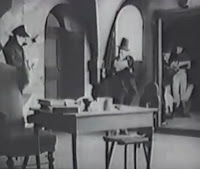Golem-blogging, essay 16 of 21
 |
| Jean Marais as Orpheus in Jean Cocteau's Orpheus (1950) will descend into the underworld through a mirror. |
 |
| Paul Wegener in The Student of Prague (1913) signs his mirror reflection away to a devil-like figure. |
Yet there must be a connection. Surely, Cocteau was a Wegener fan when he was a young man. When Cocteau was 24 in 1913 and The Student of Prague was an international hit, Cocteau must have seen it. After all, he loved movies and fantasy. How could he have missed it? A hit movie about doppelgangers and mirrors? Perhaps these images went deep, only to re-emerge years later in fascinating variations in The Blood of a Poet (1930), Beauty and the Beast (1946), and Orpheus (1950). Could Cocteau’s art have its roots in Wegener’s fantasies?
Well trained by the monster movie books I’ve devoured, I’ve always only associated The Golem (1920) with Frankenstein (1931). Even though Cocteau’s Beauty and the Beast has been one of my favorite films for nearly 40 years—just about as long as I’ve loved The Golem—I never thought about the two in conjunction before.
 |
| Astaroth in The Golem. |
In fact, the feel of both movies, the way that both celebrate primordial images that seem wrenched from the subconscious (the world of the fairy tale), is startlingly similar.
 |
| Weird characters exhaling smoke in Cocteau's Beauty and the Beast (1946). |
Watch The Golem (1920):
Purchase through Kino International
or at Amazon,
rent through Netflix,
or sneak a peek at YouTube.rent through Netflix,
© 2011 Lee Price

No comments:
Post a Comment